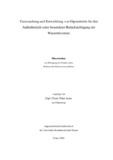Citation link:
https://nbn-resolving.org/urn:nbn:de:hbz:467-1412| DC Field | Value | Language |
|---|---|---|
| dc.contributor.author | Arens, Petra | - |
| dc.date.accessioned | 2019-09-02T09:54:47Z | - |
| dc.date.available | 2006-10-18T12:12:12Z | - |
| dc.date.available | 2019-09-02T09:54:47Z | - |
| dc.date.issued | 2002 | - |
| dc.description.abstract | Ziel der vorliegenden Arbeit war die Entwicklung von Gipsmörteln (auf Basis herkömmlicher Ausgangsstoffe), welche auch im Außenbereich geschädigter Bauwerke eingesetzt werden können. Voraussetzung für einen Einsatz im Außenbereich ist die Verträglichkeit mit dem Altmaterial sowie eine ausreichende Wasserresistenz. Das methodische Vorgehen zur Entwicklung der Gipsmörtel umfaßte die folgenden Bereiche: • Untersuchung historischer Gipsmörtel • Entwicklung einer Prüfmethodik zur Untersuchung der Wasserresistenz • Entwicklung geeigneter Bindemittelrezepturen und Mörtel • Musterhafte Applikation geeigneter Mörtel an geschädigten Gebäuden Die Untersuchung historischer Proben hat gezeigt, daß die Exposition der Mörtel im Bauwerk eine entscheidende Rolle bei der Schädigung durch Bewitterung spielt. Solche in der Praxis auftretenden Schäden (Lösungs- und Treiberscheinungen) können im Labor durch geeignete Feucht- oder Wechsellagerungen nachgestellt und die entsprechenden Verfahren für die Entwicklung wasserresistenter Gipsmörtel genutzt werden. Musterflächen geeigneter Mörtel (auf der Basis von Anhydrit, Kalk und einem Zuschlaggehalt | de |
| dc.description.abstract | The aim of this thesis was the development of gypsum-mortars (consisting of common educts) for exterior use as mortars for restoration in historical buildings. For exterior use the following conditions have to be fulfilled: compatibility with historical gypsum-mortars and a high water-resistence of the developed mortars The work included the following parts: • Investigation on historical gypsum-mortars • Development of methods for testing the water-resistance • Development of qualified binders and mortars • Application of the developed mortars for historical buildings By investigation of the historical mortars it could be showed, that the exposition of mortar in building has a great influence on the occuring damages. Damages, which occur at these buildings, had been simulated by different wet-dry changes in laboratory. Due to the fact, that there is no sign of damage at the fields of application, done at the historical buildings, it seems possible to use gypsum-mortars (based on anhydrite, lime and aggregates | en |
| dc.identifier.uri | https://dspace.ub.uni-siegen.de/handle/ubsi/141 | - |
| dc.identifier.urn | urn:nbn:de:hbz:467-1412 | - |
| dc.language.iso | de | de |
| dc.rights.uri | https://dspace.ub.uni-siegen.de/static/license.txt | de |
| dc.subject.ddc | 540 Chemie | de |
| dc.subject.other | Prüfmethodik zur Untersuchung der Wasserresistenz | de |
| dc.subject.other | Historische Gipsmörtel | de |
| dc.subject.other | Saniermörtel | de |
| dc.title | Untersuchung und Entwicklung von Gipsmörteln für den Außenbereich unter besonderer Berücksichtigung der Wasserresistenz | de |
| dc.type | Doctoral Thesis | de |
| item.fulltext | With Fulltext | - |
| ubsi.date.accepted | 2002-06-24 | - |
| ubsi.publication.affiliation | Fachbereich 8, Chemie - Biologie | de |
| ubsi.subject.ghbs | XBD | - |
| ubsi.type.version | publishedVersion | de |
| Appears in Collections: | Hochschulschriften | |
This item is protected by original copyright |
Page view(s)
538
checked on Nov 25, 2024
Download(s)
453
checked on Nov 25, 2024
Google ScholarTM
Check
Items in DSpace are protected by copyright, with all rights reserved, unless otherwise indicated.


